The planets of the solar system are grouped into three categories, based on their size and composition: They are gas giants (2), ice giants (2), and terrestrial planets (4 – including Earth).
Key Facts & Summary
- The biggest planets in the Solar System are the gas giants Jupiter and Saturn.
- Coming into second place, based on their size, are the ice giants Neptune and Uranus.
- In the third place are the terrestrial planets. Though they are the smallest, these planets are the only ones that have a surface. In order of size, they are Earth, Venus, Mars, and Mercury.
- A couple of years ago, Pluto was also considered a planet and was the ninth planet of the Solar System. However, Pluto is now considered a dwarf planet.
- Except for Earth, all the planets are named after Greek and Roman deities. The gods were associated with these planets due to certain traits, Neptune, for example, is very blue and thus it was named after the Roman god of the oceans, in Greek mythology he was known as Poseidon.
- All planets in the Solar System revolve around the Sun. They all have different intervals in which they complete one orbit around the Sun.
- Our planet, Earth, revolves around the Sun once every 365.25 days – one Earth year. Neptune, on the other hand, is the farthest planet from the Sun, and it makes one trip around it once every 165 Earth years.
- The biggest planet in the Solar System is the gas giant Jupiter. Jupiter has more than 11 times Earth’s diameter, and you would need 1.300 Earth-sized planets to fill its volume.
- The smallest planet in the Solar System is the terrestrial Mercury. Mercury is three times smaller than Earth. In comparison to Jupiter, it has more than 29 times the diameter of Mercury. It would take around 24.462 Mercury’s to fit inside Jupiter’s volume.
- Though Mercury is the closest planet to the Sun, it isn’t the hottest. Venus is the hottest planet in the Solar System since heat cannot escape from its surface.
Our Solar System is blessed with 8 planets. Every one of them is unique in their own way. Everything here formed at around roughly 4.6 billion years ago from the solar nebula.
The planets have been categorized in many ways before, but now we can safely put them into three groups: the gas giants, the ice giants, and the terrestrial planets.
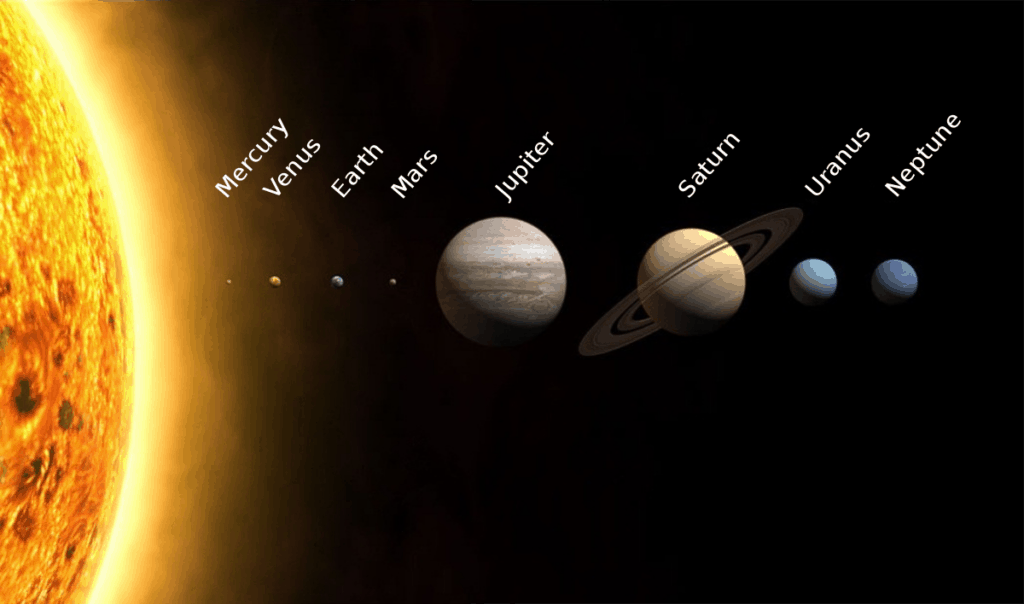
Based on their size and composition, the eight planets of the Solar System fit well in these categories. However, this isn’t the only thing that makes them special because no two planets are alike, not even when grouped together.
As such, today we are going to explore these planets and see what makes them stand out.
Terrestrial Planets Sizes
The terrestrial planets are the smallest in the Solar System. They are part of the inner solar system, being the closest to the Sun. The smallest terrestrial planet is Mercury.
Mercury has a radius of 2.439 km / 1.516 mi and a diameter of 4.879 km / 3.032 mi. It is three times smaller than both Earth and Venus. Mars is the second-smallest planet, having a diameter of 6.779 km / 4.212 mi. It is 30% bigger than Mercury and almost two times smaller than Earth and Venus.
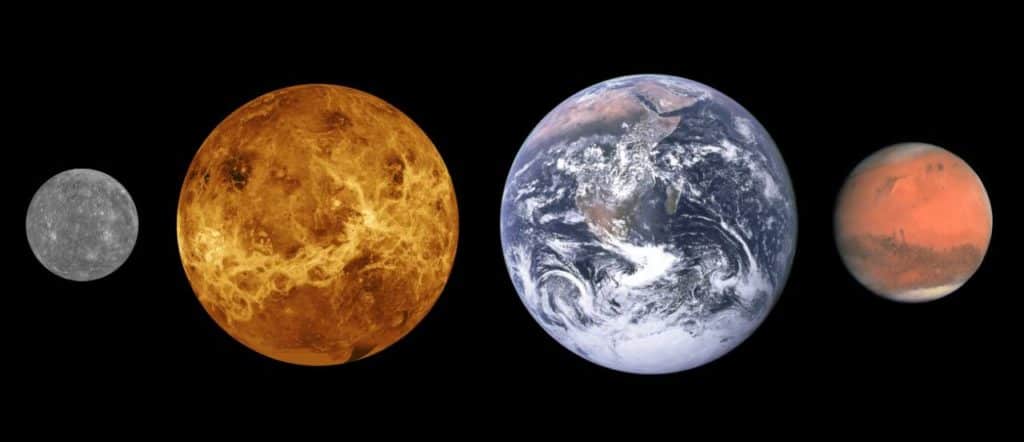
Venus is the second-biggest terrestrial planet, having a radius of 6.051 kilometers / 3.760 miles and a diameter of 12.104 km / 7.521 mi. It is only slightly smaller than Earth.
Our Earth is the fifth largest planet in the Solar System. It has a diameter of 6.371 km / 3.958 mi. It is the largest terrestrial planet. When it comes to Venus, it has about 94% of Earth’s diameter.
Terrestrial Planets Composition
The terrestrial planets Mercury – Venus – Earth – Mars, are mostly made up of rock and metal. These planets are very heavy and move slowly. They have a solid surface, unlike the gas or ice giants.
The terrestrial planets have a central metallic core composed mostly of iron, with a surrounding silicate mantle. These types of planets have common features such as canyons, craters, mountains, volcanoes, and other similar structures, depending on the presence of water and tectonic activity.
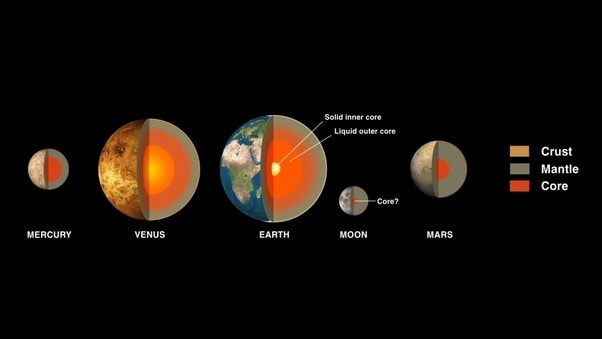
Terrestrial planets also have secondary atmospheres, which are generated through volcanism or comet impacts. This also differentiates them from gas giants, where the planetary atmospheres are primary and were captured directly from the original solar nebula.
Terrestrial planets are also known for having few or no moons. Our planet has only one moon, Mars has 2, while Mercury and Venus have none.
The gas giants, on the other hand, usually have tens of moons orbiting them. Unlike the gas giants, terrestrial planets also have no planetary ring systems.
Gas Giants Sizes
Both the gas giants and ice giants are part of the outer solar system, being the farthest from the Sun. They are separated from the terrestrial planets by the Asteroid Belt.
The gas giants are the biggest planets in the solar system. Jupiter has a mean radius of 69.911 kilometers / 43.440 miles, a diameter at the equator of around 142.984 km / 88.846 mi, and a diameter at the poles of 133.708 km / 83.082 mi. It is the biggest planet in the Solar System.
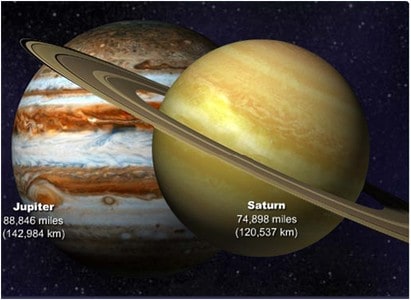
Compared to Earth, it has more than 11 times its diameter. Around 1.300 Earth’s would fit inside Jupiter’s volume. In comparison to Mercury, the smallest planet in the Solar System, it is more than 29 times its diameter. More than 24.462 Mercury’s would fit inside Jupiter’s volume.
When it comes to the second gas giant, Saturn, it has has a radius of 58.232 kilometers / 36.183 miles and a diameter of 120.536 km / 74.897 mi. It is the second-largest planet in the Solar System.
Jupiter has 1.2 times the diameter of Saturn. Saturn’s diameter is around 10 times bigger than Earth’s, and around 23 times that of Mercury.
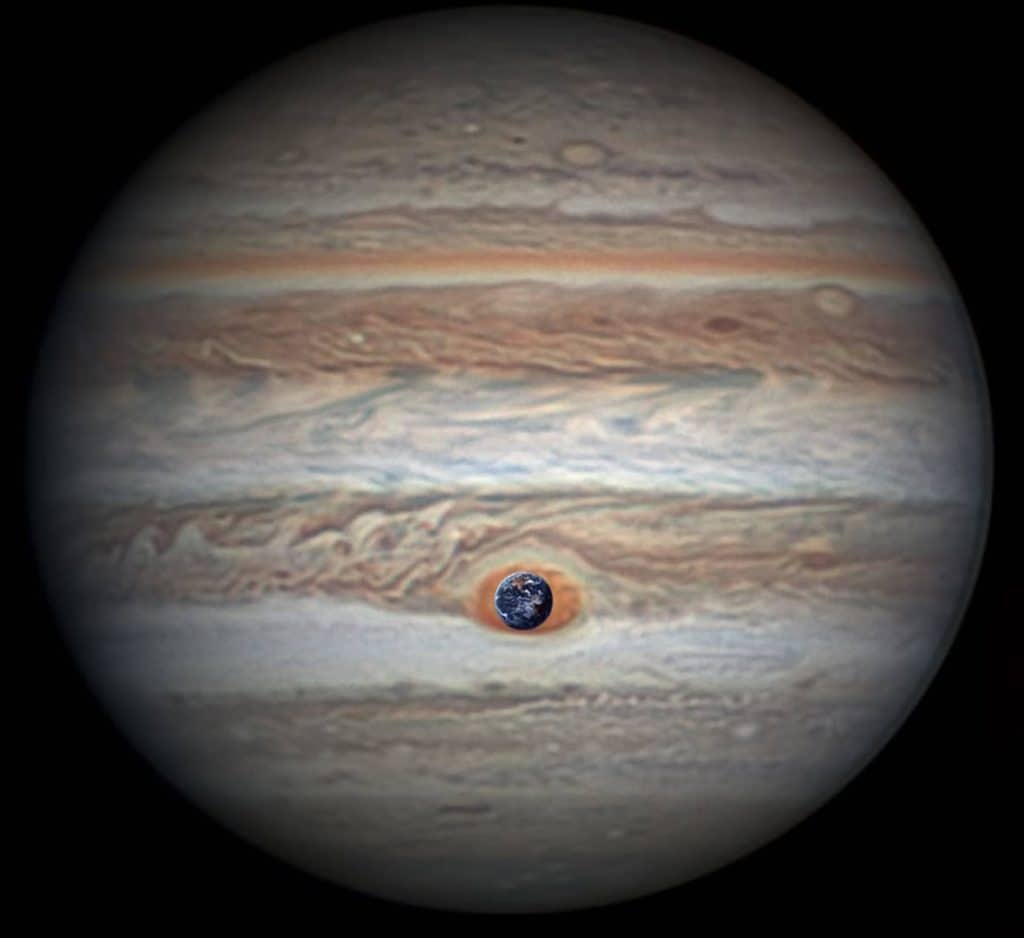
Gas Giants Composition
The gas giants are mostly composed out of gases such as hydrogen, helium, and they presumably have a small rocky core in the center. Both gas giants have over 70 confirmed moons, a lot more than the ice giants.
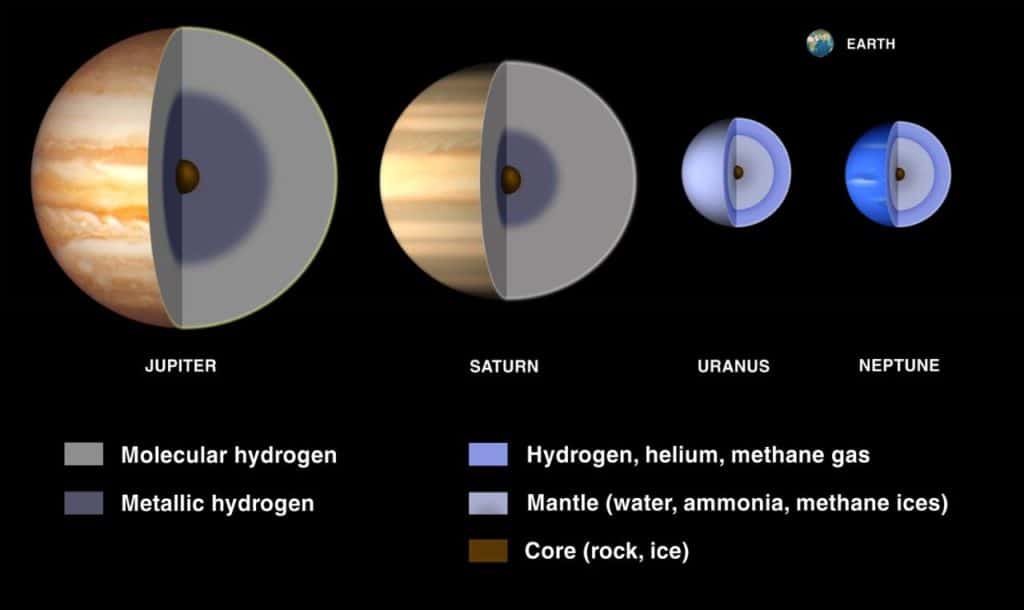
Though both ice giants and gas giants have planetary ring systems, the gas giant Saturn has by far the most prominent ring system ever seen.
Ice Giants Sizes
Ice giants are also gas giants, but they are so named because they contain less gas and are compositionally different than the gas giants. They are the farthest planets from the Sun, and though they are considerably bigger than the terrestrial planets, they are also very small compared to the gas giants.
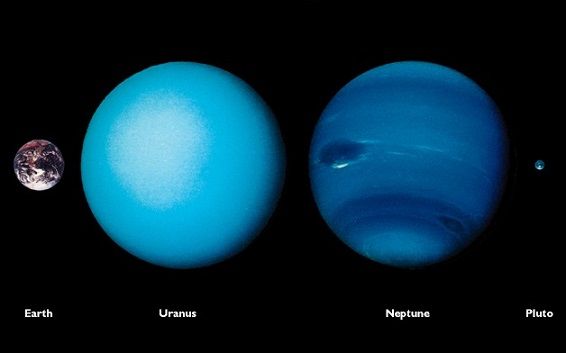
The biggest ice giant is Uranus has a radius of 25.362 km / 15.759 mi and a diameter of 51.118 km or 31.763 mi. It is the third-largest planet in the Solar System.
Uranus is slightly larger than Neptune, around 3% bigger, however, it is smaller in mass. In comparison to Earth, Uranus has four times its diameter.
Both Neptune and Uranus have 10 times the diameter of Mercury, the smallest planet in the Solar System. Jupiter, the largest planet in the Solar System, has 2.8 times the diameter of Uranus.
Neptune has a radius of 24.764 km / 15.387 mi, and a diameter of 49.244 km / 30.598 mi. It is the fourth-largest planet in the Solar System but at the same time the smallest of the giants.
Ice Giants Composition
The ice giants have an interior composition that consists primarily of what astronomers call ‘Ices’. These are compounds like water, methane, and ammonia, and are so-named presumably because they are solid at cold temperatures.
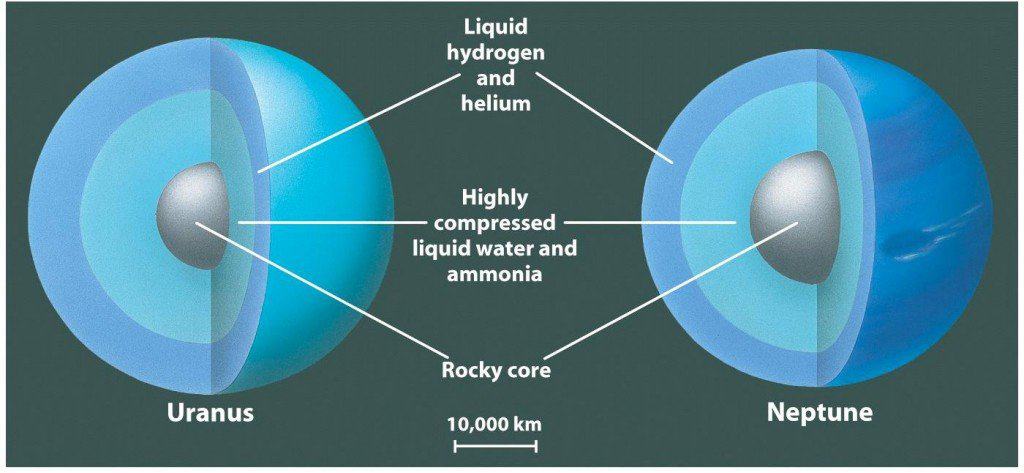
They, like the gas giants, don’t have a true surface and presumably have a small core at the center. They indeed have the lowest temperatures of any planet but they also have extremely hot regions.
Fun Facts
- Both Uranus and Neptune are blue to the presence of methane.
- Uranus and Venus rotate in the opposite direction than the other planets, from East to West. Uranus is also the only planet known to rotate on its side.
- The biggest moons of Uranus, all of them, have surface areas smaller than the continent of Australia.
- The original name proposed for Uranus was Georgian Sidus – which means Georgian Planet, in honor of King George II, however, the scientific community didn’t agree
- The particles that make up the rings of Saturn range from the size of small dust to as big a house, or even a mountain.
- Mercury orbits the Sun with a speed of around 47 kilometers / 29 miles per second. It is the fastest planet.
- Mars has seasons just like Earth, but they last longer. This is because it takes longer for it to orbit the Sun. The longest season on Mars is spring, which lasts for 194 days. Autumn is the shortest lasting only 142 days.
- If you would weigh 100kg on Earth, on Mars you would weigh 38kg because Mars’s gravity is only 38% that of Earth.
- If Jupiter would be 75 times more massive than it currently is, it would become a star just like our Sun.
- The symbol for Venus is the world symbol for the female gender, while the symbol for the planet Mars, represents that of the male gender.
- Because of its brightness, Venus has been the most confused object in the sky. Many have misreported it as a UFO, and many still do so to this day.
- Light reaches Earth from the Sun in about 8 minutes. If the Sun would vanish, we wouldn’t know it until after 8 minutes.
Trivia
Planets & Deities
Except for Earth, all the planets in the Solar System have been named after Greek and Roman gods and goddesses. Many have kept their names for hundreds of years, while the planets discovered after the invention of the telescope were named due to this tradition.
Mercury was named after the Roman god of travel, because he was swift, and the planet moves very quickly around the Sun. Venus was named after the goddess of beauty and love, because it shines very brightly, almost like a star in the sky.
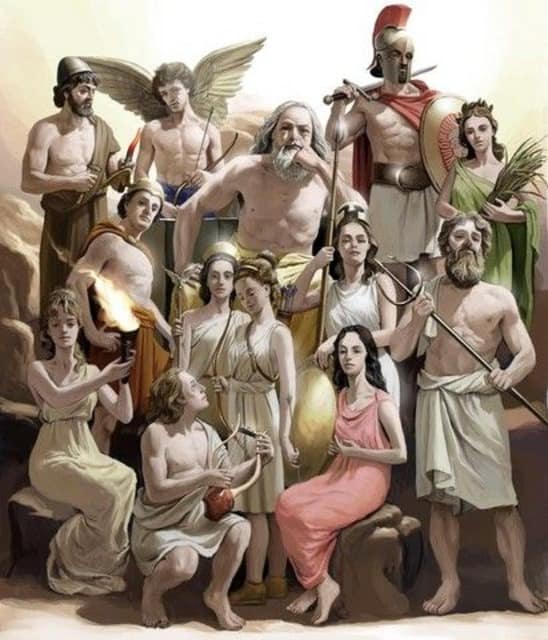
Mars was named after the god of war, because of its reddish appearance. Jupiter, after the King of the Gods probably due to the planet’s enormous size.
Neptune was believed to be a water planet because of its bluish appearance and was thus named after the god of the oceans. Uranus was named after the Greek god of the sky due to tradition, while Saturn was named after the Roman god of agriculture and time, probably due to the planet’s slow orbit around the Sun.
Time on other Planets
Time goes by differently on the other planets. However, let’s measure them based on the concept of time here on Earth: one day on Earth is 23.9 hours – this is the time it takes for the planet to rotate once on its axis, one year on Earth is around 365,25 days – this is the period it takes for our planet to complete one trip around the Sun.
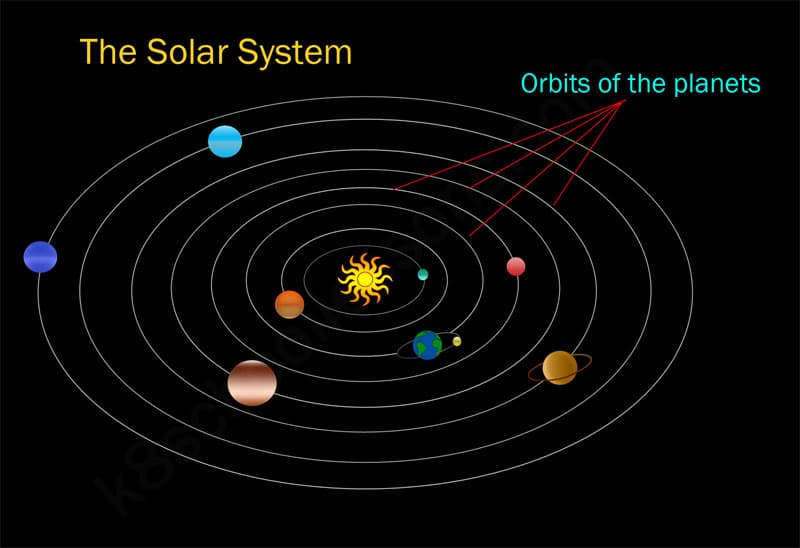
With this in mind, here is how the other planets move:
- Mercury – 1 day = 59 Earth days; 1 year = 88 Earth days
- Mars – 1 day = 24.6 hours; 1 year = 687 Earth days
- Venus – 1 day = 243 Earth days; 1 year = 225 Earth days.
- Jupiter – 1 day = 10 hours; 1 year = 11.8 Earth years
- Saturn – 1 day = 10.7 hours; 1 year = 29 Earth years
- Uranus – 1 day = 17 hours; 1 year = 84 Earth years
- Neptune – 1 day = 16 hours; 1 year = 165 Earth years
You may have noticed that some planets have longer days than years, and yes this is correct. Take Venus, for example, the Sun rises once every 117 Earth days.
Did you know?
- Wind speeds on Neptune are among the fastest recorded in the Solar System. Some may reach up to 2.160 km / 1.324 mi per hour. They are five times stronger than the strongest winds on Earth. The winds on Saturn are the second-fastest.
- Neptune is the first planet to be discovered by the use of mathematical calculations and predictions.
- NASA has mapped the entire surface of Mercury.
- Many observations and analyses indicate that Mars was once very similar to Earth, having water, or even whole oceans. Many believe that Venus was also similar to Earth billions of years ago, having even oceans, but something happened and changed all of this.
- It is not understood how, but the ancient Babylonians wrote about Jupiter around 1.300 years ago. It may be the earliest recordings of the planet.
- The surface area of Pluto is a bit bigger than Russia, or about half as wide as the United States.
- Saturn is the king of the moons because it has the most moons out of any planet, 82, and it may have even more.
Sources:
Image source:
- https://upload.wikimedia.org/wikipedia/commons/thumb/c/cb/Planets2013.svg/1200px-Planets2013.svg.png
- https://upload.wikimedia.org/wikipedia/commons/2/25/Terrestrial_planet_sizes.jpg
- https://qph.fs.quoracdn.net/main-qimg-7ca975ca35d0248e76ca266537201208
- https://nitinarcot.weebly.com/uploads/6/8/2/0/6820129/8250872.png?411
- https://www.nasa.gov/sites/default/files/thumbnails/image/pia21774.jpg
- https://solarsystem.nasa.gov/system/downloadable_items/941_gas_interiors.jpg
- https://i.pinimg.com/originals/1f/c9/c2/1fc9c21abfc4b0ca2738a0259f8dd719.jpg
- https://www.scienceabc.com/wp-content/uploads/2015/07/blue_composition.jpg
- https://comicvine1.cbsistatic.com/uploads/scale_small/13/134753/5052186-fd9ae7ccbfb9917fe74cb6e65638fa75.jpg
- https://k8schoollessons.com/wp-content/uploads/2013/05/planets-orbits.jpg
